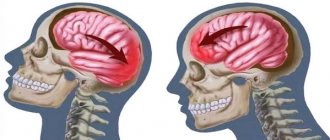The capabilities and resources of the human brain are focused on finding optimal solutions that help an individual adapt to environmental conditions and preserve life. Intelligence is an individual, dynamic characteristic that reflects an individual’s ability for mental and cognitive activity. Thanks to intelligence, a person draws conclusions and analyzes mistakes so as not to repeat them. The activity of brain structures is mainly hidden from consciousness. The brain controls a person’s feelings and movements, contracting certain muscles at the right moment, regulates the secretory activity of the glands, the functioning of the heart and the respiratory system.
Features of work
Many scientists are of the same opinion that the capabilities of the human brain are limitless, but have not yet been sufficiently studied. There are many examples that prove that the brain's capabilities have no limits. Liz Warlow is a musician with a symphony orchestra in London, plays the viola, and has been playing music since she was 8 years old. Moreover, the woman is deaf. Her hearing began to deteriorate when Liz turned 16. At the age of 19, she stopped hearing completely, which did not stop her from continuing her career as a musician.
This is one example of successful adaptation to changing conditions. Research by neuroscientists shows the possibility of increasing the number of synaptic contacts through learning. Consciousness determines the possibility of achieving a goal with the help of purposeful mental activity. Mentally imagining images of objects, imagining the desired events, a person brings the moment of implementation of his plans closer and achieves the most incredible goals.
A thought is an energy flow that arises in a neural network during the transmission of signals between neurons. Goal-oriented thinking is associated with obtaining the desired result, as a feature of interaction with others. In the process of mental activity, an individual relies on the following aspects:
- Modeling, planning.
- Experiment, forecasting.
- Causality, assessment.
- Analysis, intellectual processing, comparison of information with information stored in memory.
- Judgment, conclusions.
Skills that influence the ability to think include the ability to quickly find the necessary information in memory, compare different data, and draw logical, well-founded conclusions. Intelligence refers to the ability to perform tasks such as reasoning, planning, understanding problems and ideas, abstract thinking, learning, and language skills.
Quickly calculating the correct answers without experience in solving similar problems is an indicator of high intelligence. An individual indicator of intelligence is reflected in the IQ value, which is determined using special tests. IQ tests measure a person's cognitive abilities, his ability to understand, master, remember and apply new information.
The unlimited capabilities of the brain are manifested in its influence on the health and quality of life of the individual. An example of the influence of brain structures can be seen in the so-called placebo effect. A person is given a pill consisting of a physiologically inactive substance, calling it an effective cure for the disease. If a person believes in the miraculous properties of the medicine, his condition improves.
The hidden capabilities of the brain are not fully understood. Scientists only unequivocally state the strength of its influence on the body. Psychosomatic diseases are a consequence of depression and emotional experiences. If mental activity is impaired, the entire body suffers, which manifests itself in disruption of the functioning of organs and parts of the body. For example, memories of an injury to a limb lead to a feeling of weakening of the muscles in that limb. A person cannot move his arm or leg, although he has long since recovered from the injury.
The supernatural capabilities of the brain are illustrated by examples of high-speed counting, when a person instantly performs the operations of multiplying and dividing multi-digit numbers in his mind. Polyglots, people who can learn many languages, also serve as an example of the limitless capabilities of the brain.
The incredible abilities of the human brain are reflected in skills such as speed reading, when a person reads a book volume consisting of hundreds of pages for a few minutes, or photographic memory - the ability to remember and reproduce information placed on a sheet of paper after looking at it once for no more 1 minute. Brain abilities can be developed by regularly setting yourself intellectual challenges.
Debunking myths about the brain
Rapid advances in neuroscience mean that old information quickly becomes outdated. This is one of the reasons there is so much misinformation around the brain.
32. The information that we use only 10% of the brain is wrong. Brain scans clearly show that people use more of their brain most of the time, even when they sleep.
33. Alcohol does not kill brain cells . It causes damage to the connective tissue at the end of neurons.
34. “The Mozart effect” has been refuted . Although listening to certain types of music can improve memory and concentration, there is nothing unique about listening to Mozart.
35. You may have heard that we have more brain cells than stars in the Milky Way, but this is not true. According to the most rough estimates, there are 86 billion neurons in the brain, and 200-400 billion stars in the Milky Way .
36. It is often said that the length of blood vessels in the brain is 16,000 km. In reality this number is closer to 1000 km.
37. Contrary to popular belief, high total cholesterol is not harmful to the brain. Moreover, high cholesterol levels reduce the risk of developing dementia.
38. Until recently, it was generally accepted that a person is born with a certain level of intelligence and number of brain cells.
In fact, the brain has the ability to change throughout life due to a property known as brain plasticity.
The brain can also continue to form new cells through neurogenesis.
Cognitive technologies
Cognitive technologies reflect the processes of human cognitive activity. The principle of the human brain is used in artificial intelligence systems. An example is video cameras that are installed along the highway to monitor the faces of car drivers. Artificial intelligence systems are able to determine in a split second that the driver looks tired and is about to fall asleep.
Such innovations are designed to reduce the number of accidents on the roads, which in most cases occur due to the fact that a tired driver has lost vigilance and the ability to concentrate. Another example of cognitive technology is compact video cameras that are mounted on the shoulder of visually impaired people.
The system scans the surrounding space, determines street names and house numbers, voicing information to the owner, which allows a blind person to navigate the city streets without an accompanying person. The cognition of machines and electronic devices is associated with the characteristics of the human brain.
Artificial intelligence systems are capable of perceiving information, processing and analyzing data, drawing logical conclusions, and self-learning. Cognitive technologies are the most important achievements of our time. Cognitive science combines knowledge from different fields - philosophy, psychology, neurophysiology. The picture of reality within the framework of cognitive science is presented in the form of measurements:
- Objective universe.
- Subjective image within the objective world.
- Interaction between reality and representation (secondary subjective representation of reality).
The relationship between actual reality and ideas about it reflect the adaptive abilities of the individual. In terms of adaptation to environmental conditions, the degree of its adequacy is of great importance. Cognitive science is the body of knowledge and technology used to enhance the capabilities of our brains.
A distinctive feature of technology is its social and practical benefits. An example of the use of cognitive technologies is the formation of virtual reality in the process of professional training of drivers, pilots, astronauts, and dispatchers.
The influence of modern lifestyle on the brain
Life changes our brain. And not always for the better.
Interesting facts about the human brain
“Your brain, Doctor, is a breeding ground for question marks.”
Paul Valerie
23. Chronic stress and depression are widespread in modern life. This can cause measurable shrinkage of the brain.
24. Modern diets low in omega-3 essential fatty acids result in brain shrinkage equivalent to two years of structural brain aging.
25. Average IQ declines by 1.6 points per decade.
26. Technology is forcing most of us to become “multitaskers.” But our brain cannot concentrate on two things at the same time. He can quickly switch between tasks.
Multitasking reduces attention span, learning ability, short-term memory and overall mental performance.
27. Teens are more likely to forget what day it is or where they put their keys than their parents.
28. Intervals of increased concentration become shorter. In 2000, the average attention span was 12 seconds. Now it's 8 seconds.
This is shorter than the 9-second attention span of some fish.
29. Brain cells eat each other as a last source of energy to prevent death. Thus, a diet, especially a low-fat diet, can cause the brain to eat itself.
30. More than 140 types of proteins in the brain are negatively affected by electromagnetic frequencies emitted by cell phones and other electronic devices.
31. Using GPS for navigation destroys our innate sense of orientation , a skill that our ancestors have had for millennia.
When areas of the brain involved in orientation are no longer used, the neural connections between them disappear.
Amazing Brain Powers
Brain activity does not stop for a minute, even when a person sleeps and turns off his consciousness. The human brain is capable of continuous activity, which does not stop during sleep, which allows even the night to be used to master new information.
During sleep, when consciousness is completely turned off, our brain continues to work, for example, sorting memories, eliminating unnecessary ones and strengthening useful ones. Research shows that when a person sleeps, they are better able to remember the skills they practiced during the day.
In the slow phase, there is a better assimilation of facts and information material. In the fast phase, physical movements practiced by dancers, athletes, and musicians are consolidated. The human brain is capable of maintaining biological ri without any external reference points, as was clearly demonstrated during an experiment by American neurophysiologist Nathaniel Kleitman.
The researcher who pioneered the scientific study of the phenomenon of sleep spent a month in a dark, unlit cave to find out when the sleep-wake cycle would be disrupted. According to his theoretical calculations, there should have been a failure from the 24-hour cycle. However, over the course of a month, the scientist’s brain clearly determined when it was day and night, when he needed to wake up and go to bed. Amazing abilities of the human brain:
- Creating false memories. Experiments have shown that about 70% of people can easily be persuaded to believe in fictional events. For example, making them think they have committed a theft or assault. Moreover, the participants in the experiment began to have their own memories of fictional crime stories. The explanation for the phenomenon lies in the brain’s ability to fill gaps in memory when a person tries hard to remember something. Inaccurate or unreliable information is used.
- Prediction of the future. The perception of stimuli coming from the external environment is accompanied by instant prediction of probable outcomes, which allows the body to adapt to the conditions of the surrounding reality. This function allows you to predict the future based on available aggregate information. A person is not always aware of the sequence of logical conclusions made by the brain at a subconscious level. For this reason, the ability to predict events seems mystical and is called intuition.
- 360° view. Every person has at least once experienced the feeling that someone is watching them. Moreover, the observer is out of sight. The explanation of the phenomenon lies in the ability of sensitive receptors to perceive external stimuli much more widely than a person realizes. Buddhist monks learn to find objects with their eyes closed and hit them with a sword or stick. The ability is called the “sixth sense”.
- Instant assessment of surrounding people and objects. A person needs just a tenth of a second to evaluate a new acquaintance or someone they just meet. The brain instantly summarizes the information that comes from visual, auditory, and olfactory receptors, analyzes the information, compares the data with accumulated experience and draws conclusions.
- Acting as an alarm clock. Some people understand what we're talking about. Without any additional devices or clocks, they wake up at the same time in the morning. If a person follows a routine—goes to bed and gets up at approximately the same time—the biological clock of the brain adjusts the body to the schedule. For example, by the time you wake up in the morning, the muscles, organs of vision and hearing are activated.
- Sleep learning. During the experiments, sleeping people were given information of different content to listen to - musical, textual, which until that moment was unknown to them, unfamiliar. After waking up, when repeating musical or text fragments, the experiment participants confidently stated that they had already heard this before. For example, after listening to a piece of music played during sleep, they claimed that these sounds seemed familiar.
- Innovating and learning through imagination. Imagination has provided the basis for many remarkable scientific discoveries, such as the theory of probability developed by Einstein. Thanks to imagination, a person can learn to play a musical instrument without ever picking it up. Experiments have proven the validity of this teaching method. Participants in the experiment were explained in words how to place their fingers and what sounds the instrument made. In the end, they were all able to play the melody they had learned without using a musical instrument.
- Working in autopilot mode. When a person thoroughly masters a certain skill, the brain connects structures that subsequently allow actions to be performed automatically without the conscious participation of the individual, on autopilot. We are talking about skills that have become automatic, for example, the movement of fingers when performing a well-learned piece of music. An example would be “blind” keyboard operation.
A study of the human brain has shown that the subconscious makes mistakes much less often than the conscious mind. The human brain processes more information at a subconscious level than a person is aware of. When drawing conclusions, the subconscious is not distracted by emotional and subjective factors and relies solely on the results of comparison with previous experience.
Facts about the brain and memory
It was once thought that the brain recorded memories like a camera, but that is not how memory works.
Rather than being a discrete record of experience, the creation of memory is more like the creation of improvisational jazz.
Interesting facts about the human brain
"That. what we think is much less complex than what we think it is.”
Stanislav Lem
39. The brain peaks for different cognitive skills at different ages. At any given age, you are likely to get better at some things and worse at others.
An extreme case is vocabulary, which may reach its peak after the 70th birthday!
40. If you drank alcohol and don't remember what you did last night, it means you forgot it. While you are drunk, your brain is unable to form memories.
41. Exceptional memory is a skill that can be developed , not an innate ability.
How to develop
To develop the abilities of the brain, you need to regularly load it with intellectual tasks, such as memorizing new information, mastering new skills, solving puzzles, crosswords, mathematical and logical tasks. As part of the development of mental abilities, the principles of a healthy lifestyle are encouraged, including daily physical activity and a nutritious, balanced diet.
The possibilities of the human brain are limitless. It depends only on the person what milestones he will achieve during his life.
How does the human brain work?
The brain works around the clock. When we sleep, he does not stop working. And, even when a person is in a coma and unconscious, his brain functions.
The brain consists of two hemispheres. They vary in size and are responsible for different human abilities.
- The right hemisphere is responsible for creative thinking and visual imagery.
- The left hemisphere is for logical thinking.
The brain is a kind of human steering wheel. He does a great job every day. Performs countless tasks.
Just as you cannot find two identical people, you cannot find two people who think alike.
Facts about brain shape and function
The “design” and functions of the human brain are unique.
42. Human brain tissue is loose . They are very fragile and soft, similar to the consistency of soft tofu or gelatin.
43. The brain generates approximately 100 ml. liquids every day. It floats in this bath of cerebrospinal fluid, which acts as a shock absorber, preventing the brain from being crushed by its own weight.
44. Half a brain can work like a whole brain. To stop the seizures, surgeons sometimes remove or disable half the brain in a procedure known as a hemispherectomy.
It does not affect the personality and memory of patients.
45. Although pain signals are processed in the brain, the brain itself has no pain receptors and does not feel pain. This explains how brain surgery can be performed without anesthesia.
Headaches are caused by sensations in the skin, joints, blood vessels, or muscles.
46. According to research conducted at the University of Cambridge, the order of letters in a word does not matter much to your brain.
As long as the first and last letters are in place, the brain can rearrange the letters so that you can form words as quickly as you can read.










